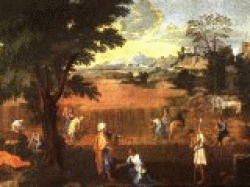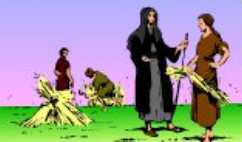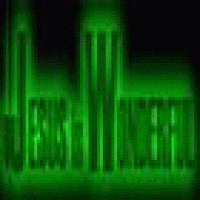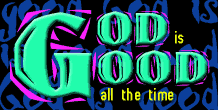|
BACKGROUND
1. WHAT IS AN ALLEGORY?
2. 'TYPES' IN SCRIPTURE
3. LIFE IN THE TIME OF RUTH
4. THE JEWISH 'SOCIAL WELFARE' SYSTEM
5. A KINSMAN-REDEEMER
.......THE KINSMAN-REDEEEMERS OBLIGATIONS
6. WHEAT AND BARLEY
.......BARLEY
.......WHEAT
.......THE HARVEST
.......THRESHING AND WINNOWING
The
full background to this teaching is available online at this link
Book of Ruth Background
|
Online links to scriptures (New International Version [NIV] unless otherwise stated) are shown in blue
| The first two sections have been retained for reference purposes during your study. You may prefer to directly scroll down to to the new teaching from Chapter 3. |
|
|
| THE PRINCIPAL CHARACTERS |
|
To understand today's application of this amazing 'story' we must appreciate who or what each of the principal characters represents. So it is here we need to start.
|
| BOAZ: A type of Jesus. |
|

Galatians 3:13-14
His name means, 'in him is strength'. Boaz was the 'Kinsman Redeemer' (restorer) of Naomi and Ruth. Jesus is our redeemer.
Interestingly, the two pillars at the front of Solomon's Temple were named Jachin; 'He will establish' and Boaz; 'In Him there is strength.' Here we have the perfect picture of Jesus upon His return to reign in authority and power.
However He first came in weakness, as symbolized by the Tabernacle of Moses A perfect picture of us, today's believers, walking in the weakness of imperfection through the wilderness with Christ, as did the children of Israel so long ago. But He also overcame sin and death on the Calvary's cruel Cross, which we celebrate today, as typified by David's Tabernacle. While finally, the glory of the Temple pictures Christ's millennial reign! (See 'A Revelation of……. The Three Houses of Worship'). It was this final kingly reign that both the Jews, and many unbelievers today, expected Jesus to institute when He first came! The concept of a servant king to be imitated had and has much less appeal!
|
| NAOMI: Type of the Jewish people and then the "Jewish church" |
|
Naomi is a classic picture of a Jewish matriarch who, typical of women generally, is the power behind her husband's throne. But tragically, her husband, Elimelech (Meaning ' My God is King') dies. With extreme difficulty in the culture of the time, Naomi had to assume headship of the family. When things didn't go well, she cried out for her name to be changed from Naomi (my pleasantness) to Mara (bitter). But once the opportunity arises, her life quickly becomes focused on rectifying this situation through her daughter-in-law, Ruth.
|
| RUTH: Type of the gentile church. |
|

Ruth was a foreigner, from the land of Moab, (today's central Jordan) who was married to one of Naomi's two sons, Mahlon (puny, sick) or Chilion (pining, failing). Moab had a long history of conflict with the Jews, going back to the time when the Moabite King refused to let the Israelites pass through his land, shortly after their escape from a 400 year captivity in Egypt. This antagonism and conflict continued and intensified throughout the centuries that followed. Ruth, being a Moabitess was as 'unjewish' and as low as you could go in the Jewish societal structure of the day. So for her to return to Israel with her mother-in-law after the death of both their husbands, was a huge act of self-sacrifice.
|
| ORPAH: Type of the end time church that falls away. |
|
Orpah (back of the-neck, mane, stubborn) married Naomi's other son during the time the family spent in Moab, while escaping the drought in Israel. Orpah started on the journey back to Israel, but on the advice of Naomi, took the easy (and seemingly sensible!) option of returning to her family and remaining in Moab, in itself a type of 'the world'.
|
| TO THE JEWS |
|

The story represents a picture of the transformation of Naomi from despair to happiness and cultural fulfilment, through the selfless acts of Boaz and Ruth.
This is well expressed in a Jewish description of the traditional reading of Ruth on the Feast of Shavout, or Pentecost, as Christians know it.
"Reading of the Book of Ruth: On the morning of Shavuot, we read the Book of Ruth, one of the "five scrolls". The book is the story of Ruth, a Moabite who chose to convert to Judaism, and was the great-grandmother of King David. There are many reasons for this custom. One has to do with the main character of the book, Ruth. Ruth was a convert, meaning she took upon herself the yoke of Jewish law. So too on Shavuot, as we celebrate the giving of the Law, we take upon ourselves a new the yoke of the Torah." (http://www.geeboosh.com/shavuot.htm)
|
| TO CHRISTIANS |
|

A picture of Jesus (Boaz) and His care for His end time combined Gentile (Ruth) and Jewish (Naomi) Church.
This amazing truth is revealed in a simple story, ironically in one of only two books in the Bible that has no mention of God. A story that took place nearly 3,000 years ago. A family tragedy, ending in a family restoration. Yet, this seemingly simple story contains Kingdom truths revealing God's plan for His church in these end times.
Let's look closer, shall we?
|
| UNDERLYING SPIRITUAL MEANING:
A PICTURE OF THE END TIME CHURCH |
|
|
| 3:1-3:9 BOLDNESS REQUIRED |
|
Ruth 3:1-9
Ruth is persuaded by Naomi to step out, taking a risk to assure both of their futures by approaching Boaz at the "male only" threshing floor. This was a huge risk to take, as in normal circumstances Ruth would have been seen as a harlot, for doing such a thing.
Speaks of our need to be bold in Christ, to step out in faith, breaking tradition and comfort zones to obtain the rewards He offers. Also that the harvest is not complete until the "threshing" or "training in God's ways" of converts is completed.
|
| 3:10-3:14 COMMITMENTS REWARD |
|

Ruth 3:10-14
Boaz is both flattered and honored by Ruth’s approach and subject to satisfying the custom of the time, agrees to marry her, recognizing her status as a "woman of noble character."
Jesus rewards those who step out in Him with a closer "tabernacle" relationship with Him. As we step out in holiness, so our relationship with Jesus deepens.
|
| 3:15 A PURE HEART'S REWARD |
|

Ruth 3:15
Boaz poured six measures of barley into her shawl as a gift.
A gift of souls given because of the example she had set. Illustrated by her shawl (or cloak) symbolising a covering of righteousness, reflecting that which is within. This too, is an example to others.
|
| 3:16-3:18 HARVEST GRATEFULLY RECEIVED |
|

Ruth 3:16-18
Naomi receives the gift, highly relieved that her judgement of Boaz has been right. She now acknowledges the righteousness of the giver, knowing that Boaz will pursue the steps necessary to arrange for the marriage.
Harvest is the reward for righteousness and obedience. The Gentile end time church is created first (Boaz and Ruth) and the Jewish church (Naomi) is then added, as the Gentile church reflects God's glory to the Jews.
|
| <i>NEXT WEEK</i>
A REVELATION OF…….THE BOOK OF RUTH
|
|
 Continues with a look at the final chapter, Chapter 4. See its implications for our church today. Continues with a look at the final chapter, Chapter 4. See its implications for our church today.
|
| A NOTE FROM DAVID |
|
 This is a key chapter - for Ruth and us. Yes, she went out of her comfort zone, risking everything she had accomplished so far, in order to receive the ultimate reward! This is a key chapter - for Ruth and us. Yes, she went out of her comfort zone, risking everything she had accomplished so far, in order to receive the ultimate reward!
Are we prepared to do the same?
Well, today you can decide whether or not you like the beard! Only trouble is, it's very difficult to stick the other half back on again if you do!
|
So until next week.......
MAY GOD BLESS YOU AND YOU BLESS GOD!
His servant and yours

Learn more about us at...
www.wwj.org.nz/about.php
|
A DAVID'S DOODLING
A foolish person speaks before they think, a wise one thinks before they speak, but a godly person lets their life speak for them.
David Tait
|
Check
out the WWJ website for….
More David's Doodlings: www.wwj.org.nz/dd.php
God Facts (A mine of information): http://www.wwj.org.nz/gfacts.php
Facts for Fun: http://www.wwj.org.nz/facts.php
Marriage and Family Facts: http://www.wwj.org.nz/maffacts.php
Just jokes: http://www.wwj.org.nz/jokes.php
|








 Continues with a look at the final chapter, Chapter 4. See its implications for our church today.
Continues with a look at the final chapter, Chapter 4. See its implications for our church today.  This is a key chapter - for Ruth and us. Yes, she went out of her comfort zone, risking everything she had accomplished so far, in order to receive the ultimate reward!
This is a key chapter - for Ruth and us. Yes, she went out of her comfort zone, risking everything she had accomplished so far, in order to receive the ultimate reward!